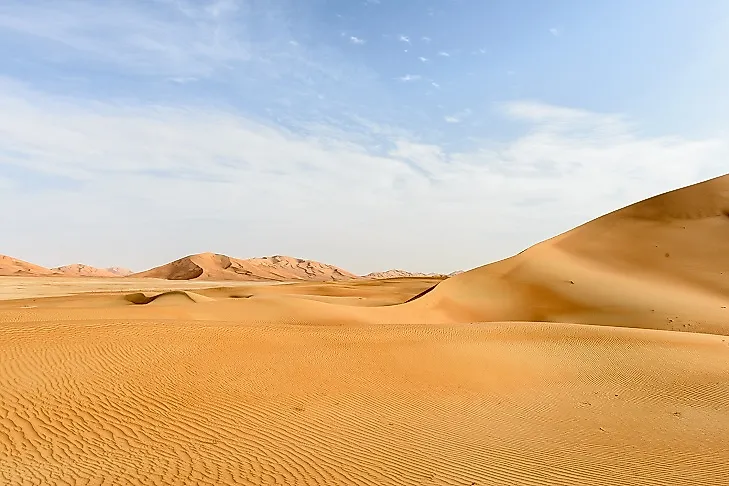Rub al Khali, Empty Quarter Of The Arabian Desert

5. Description
Part of the Arabian Desert, the Rub al-Khali, meaning ‘empty quarter’ in Arabic, is the largest region of continuous sand in the world, and the driest. It lies in a structural basin and stretches across an area of roughly 250,000 square miles (650,000 square kilometers.) Rub al-Khali lies mainly in Saudi Arabia with portions in United Arab Emirates, Yemen and Oman. The Empty Quarter features a varied topography. The elevation is as high 2,000 feet (610 meters) above sea level in the west and slopes down to about 600 feet (180 meters) in the east. In the western parts of the desert, the sand is fine and soft while the opposite spectrum contains sand dunes, salt flats, and plains of gravel and gypsum. The sand is reddish-orange due to the presence of feldspar.
4. Historical Role
There are raised and hardened areas comprising calcium carbonate, gypsum and clay that were shallow lakes 6,000 to 2,000 years ago. Fossil remains represent various fauna and flora at the site of the dried-up lakes. Chipped flint tools reveal human activity in the vicinity 3,000 to 2,000 years ago. Before desertification made regular navigation virtually impossible, trade caravans carried frankincense across Rub al-Khali until about 300 AD. It is also thought that a city called Ubam, or Iram, which once existed in the desert, depended on the trade. Camel tracks appear in satellite images, which are unidentifiable on the ground. The first journeys across Rub al-Khali by visitors were made by British explorers Bertram Thomas and St. John Philby in 1931 and 1932, respectively.
3. Modern Significance
Rub al-Khali has vast reserves of oil and natural gas beneath its sands. Al-Ghawar is the largest oil field in the world and was discovered in 1948 in the northeastern part of the sane sea. It stretches on a roughly north-south axis for 160 miles (260 kilometers) and contains billion and billions of barrels of oil. Another significant reservoir is Al-Shayba in the southeast near the United Arab Emirates and Oman. The oil refinery also has large reserves of natural gas under it. Rub al-Khali is sparsely populated by the Bedouins from a number of tribes. These are the Banu Yam and Banu Hamdan of Yemen, the Najran region of Saudi Arabia, and Bani Yas in the United Arab Emirates. Historically nomads, today these sturdy people transport their newfound oil wealth through a few road links which connect their settlements to urban areas. Several international projects have targeted Rub al-Khali for scientific studies, in collaboration with Saudi Arabia and the other national stakeholders.
2. Habitat and Biodiversity
The Empty Quarter inherently has the same type of hot desert climate typical of most of the Arabian Desert. It falls under the ‘hyper-arid’ category with annual rainfall of less than 3 centimeters, with some places not receiving any at all during a given year. Daily temperatures can reach as high as 51 degrees Celsius (or 124 degrees Fahrenheit). The climate of the region supports arachnids like scorpions and spiders and rodents. However, drought-tolerant plants and shrubs can be fund throughout the desert.
1. Environmental Threats and Territorial Disputes
In modern times, the primary geopolitical and socioeconomic disputes that arise in the Rub al-Khali are related to disagreements between governments and business from both Arabian nations and afar over the exploration and extraction rights of natural resources, particularly petrochemicals and water, in the region. In terms of environmental concerns, the Asiatic cheetahs were once widespread throughout the Empty Quarter, but are now regionally extinct. The Arabian oryx, ostrich, and sand tigers also thrived in the area until recently, but have now also disappeared due to droughts and hunting.











